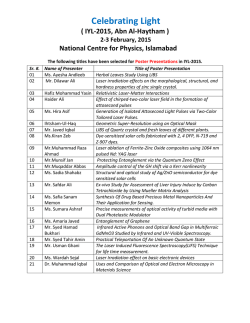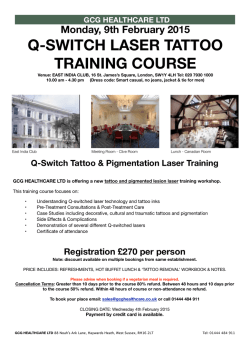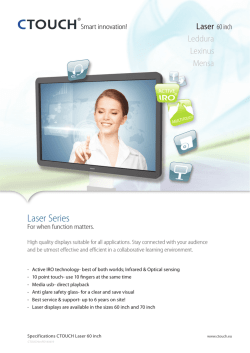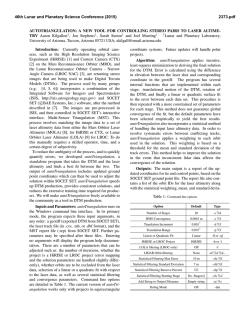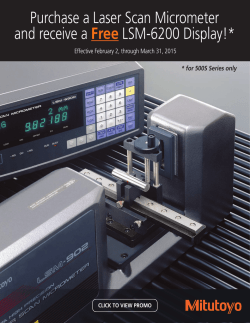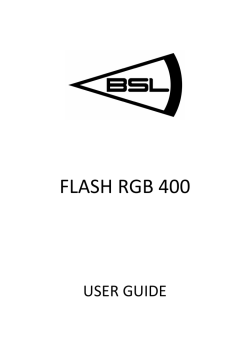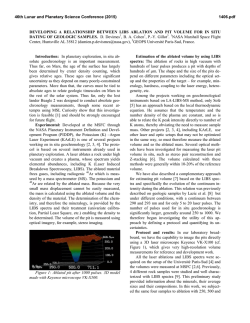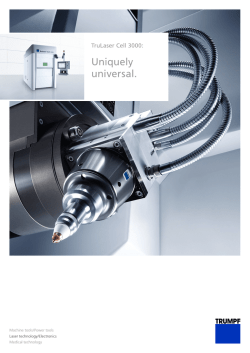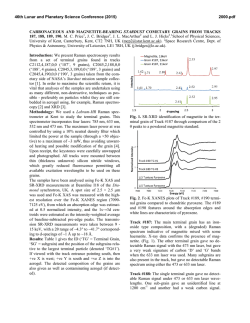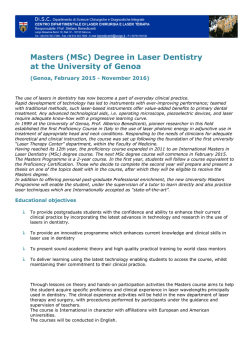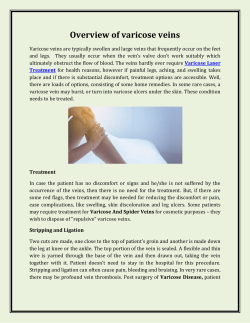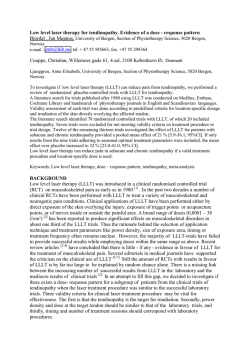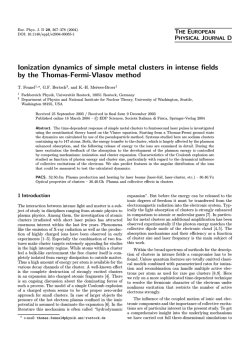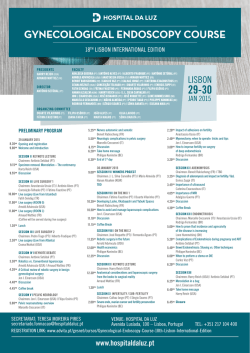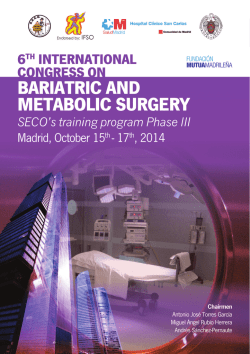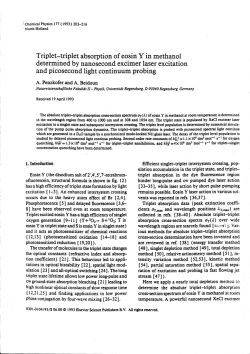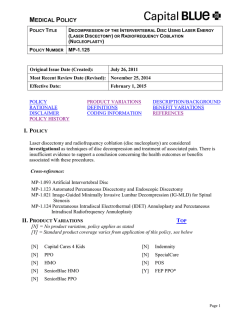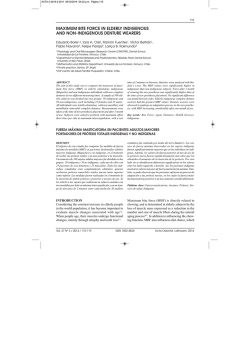
Laser vestibuloplasty. Case report - edigraphic.com
www.medigraphic.org.mx Revista Odontológica Mexicana Vol. 18, No. 4 Facultad de Odontología October-December 2014 CASE REPORT pp 259-262 Laser vestibuloplasty. Case report Vestibuloplastia con láser. Reporte de caso Myriam Amparo Pulido Rozo,* Meisser Vidal Madera Anaya,§ Lesbia Rosa Tirado AmadorII ABSTRACT RESUMEN One of the greatest challenges when rehabilitating fully edentulous patients, is to manufacture a denture to be placed on an alveolar ridge with advanced bone resorption. This requires performing preprosthetic surgery and prepare groundwork bone and surrounding soft tissues to receive a tissue-borne prosthesis, as well as providing suitable retention and support. This will elicit lesser trauma and thus allow prompt tissue healing. The case here presented is that of a 56 year old female, with non-contributory medical history. The patient had been wearing dentures for the last 14 years; her dentures were ill-adapted. Intra-oral clinical examination revealed collapsed and re-absorbed ridges. Due to a lack of retention in the lower ridges, a laser surgery was performed to deepen the vestibule. 18 days after surgery tissues were completely healed, the vestibule had recovered 6 mm depth in the anterior section and 4 mm in the posterior section. Rehabilitation was completed with the manufacture of full bimaxillary dentures. It was thus concluded that laser vestibuloplasty confers depth to the vestibule and offers the advantages of laser incision, which decreases hemorrhage, provides better operating field and reduces post-operative inflammation and pain. En pacientes edéntulos totales, uno de los desafíos para rehabilitación bucal es la confección de prótesis en un reborde alveolar con avanzada resorción ósea, lo que hace necesario realizar cirugías preprotésicas que preparen las bases óseas y los tejidos blandos circundantes para recibir la prótesis mucosoportada, brindando retención y adecuado soporte; además de generar menor cantidad de trauma posible, permitiendo la pronta cicatrización tisular. Se presenta el caso de mujer de 56 años, sin antecedentes médicos relevantes. Refiere portar prótesis totales desde hace 14 años, las cuales se encuentran desadaptadas. Al examen clínico intraoral se observan rebordes colapsados y reabsorbidos. Debido a la falta de retención en los rebordes inferiores, se realizó cirugía de profundización del vestíbulo con láser. Se obtiene a los 18 días tejido completamente cicatrizado, con una recuperación en profundidad del vestíbulo de 6 mm en sector anterior y 4 mm en posterior. Finalmente se rehabilita con prótesis total bimaxilar. Se concluye que la vestibuloplastia láser permite profundizar el vestíbulo y ofrece las ventajas de la incisión láser que disminuye la hemorragia, brinda mejor campo operatorio, disminuye la inflamación y el dolor postoperatorio. Key words: Laser therapy, low intensity laser therapy, vestibuloplasty. Palabras clave: Terapia por láser, terapia por láser de baja intensidad, vestibuloplastia. INTRODUCTION In fully edentulous patients, maxillary atrophy can be defined as the advanced physiological reduction of alveolar apophyses. This can be due to multiple factors among which we can count pre-existent periodontal disease, endocrine and systemic disorders, diet factors, anatomical and mechanical considerations, gender, and facial morphology.1 It might be one of the most incapacitating oral conditions; the reason for this lies in its nature which is chronic, progressive, accumulative and irreversible. It represents one of the main problems when trying to rehabilitate a totally edentulous patient with a tissue-borne full denture, since this conventional treatment is acceptable when there is sufficient alveolar ridge to support the denture.1-3 Nevertheless, in cases when alveolar atrophy is advanced, patients afflicted with severe retention problems can benefit from preprosthetic surgery procedures in order to obtain a wider bony base.1,4 One pre-prosthetic alternative would be vestibule deepening, or vestibuloplasty following Edlan Mejchar technique. This technique was described in 1963 and particularly applies to cases where there is scarce or no remaining attached gum tissue. This technique is additionally adopted in an effort to overcome complications of post-operative loss of vestibule depth, which occurs in other techniques. This technique purports a successful prognosis, since it assesses the patient’s comfort and maintenance www.medigraphic.org.mx * § II Master in Public Health, Periodontist, DDS, Professor at the School of Dentistry, University of Cartagena, Colombia. DDS, Research Assistant, School of Dentistry, University of Cartagena, Colombia. DDS, University of Cartagena, Colombia. This article can be read in its full version in the following page: http://www.medigraphic.com/facultadodontologiaunam Pulido RMA et al. Laser vestibuloplasty 260 of the prosthesis in the surgically created vestibular extension. Laser application of the Edlan Mejchar technique offers the possibility of deepening the vestibule, facilitating thus post-operative procedures and allowing to reduce healing time in the tissues and so achieve prompt rehabilitation.5 Currently use of laser is widely accepted in the field of dentistry. Laser is applied in multiple procedures, according to their intensity. Low intensity lasers are mainly used to achieve bio-stimulating, analgesic and anti-inflammatory effects. High intensity lasers are used to prepare cavities, eliminate old fillings, seal pits and fissures, tooth hyper-sensitivity in order to prepare root canals in endodontics, in esthetic dentistry to manufacture dental veneers, tooth whitening, dental prostheses to prepare the tooth to receive crowns, in oral surgery to extract impacted teeth, apical surgery, osteotomy, and exeresis of pre-malignant lesions in soft tissues.6,7 Case report A 56 year old female patient attended our services dissatisfied with esthetic appearance as well as function. The patient’s history was non-contributory, she informed of wearing full dentures for the last 14 years; dentures were ill adapted and in poor esthetic circumstances. Stomatological examination revealed clinical absence of all teeth, thick upper alveolar ridge, with optimum height, collapsed lower ridges with advanced resorption (Figure 1). Palate mucosa was swollen, of an intensely red color and papillary appearance. Clinical impressions were false anodontia and type 3 sub-prosthetic stomatitis. Treatment plan suggested was oral rehabilitation with upper and lower full dentures. Lack of retention present due to resorption of lower ridges prompted pre-prosthetic surgery in order to deepen the vestibule with the help of a laser beam. Surgical procedure Infiltrative local anesthesia was applied in the intervention area, between teeth 36 and 46. An incision was then performed, using diode surgical laser AsGaAL 4 w, with equipment Pocket laser, Orotig Med aiming beam class 3R Laser 3mW CW (MAX) 635 nm power beam class 4 Laser 6 w cw (MAX) with 915 nm beam engagement. Central and lateral frena were subjected to frenilectomies, the vestibule was deepened. At the same time refrigeration was achieved with triple syringe, six gauzes were used in all the procedure to induce hemostasis. The low amount of bleeding present obviated the need to suture (Figures 2 and 3). To complete the procedure, a low intensity laser was used during 3 minutes (AsGaAL, 685 nm) in order to stimulate healing (Figure 4). Surgical time was approximately 10 minutes, when procedure was completed, nimeluside-type analgesic was prescribed (100 mg every 24 hours), no antibiotic coverage was used. Extra-oral ice applications were recommended to be used in the first day. The first control took place 24 hours after procedure. No edema could be observed. Upon applying pain, assessment with EVA scale (0 to www.medigraphic.org.mx w ww.medig phic.org.mx Figure 1. Lower alveolar ridges with advanced bone resorption. Figure 2. Use of surgical laser in the lower vestibule. Revista Odontológica Mexicana 2014;18 (4): 259-262 261 Figure 5. Control image 24 hours after surgical procedure. Figura 3. Results observed after surgical laser use. EEste Es ste te documento doc ocum meennto to eess el eelaborado lab la aboorrad ado po por Me por M Medigraphic eddiigr grap aphi hic Figure 4. Use of low-intensity laser application to achieve bio-stimulating effect. 10), the patient reported a number three score. At that point a second therapeutic laser application was performed (Figure 5). Second control was undertaken eight days after procedure. Remarkable recovery and absence of pain were observed, after this, a third therapeutic laser application was performed. After 18 days, the third control was undertaken. Fully healed tissue could be observed, tissue was in optimum conditions to take preliminary impressions as well as for full denture recording. In anterior and posterior areas of the vestibule a respectively 6 and 4 mm depth recovery could be observed (Figure 6). Finally, 28 days after surgery, the patient was rehabilitated with bi-maxillary full dentures. At later control assessments, the patient informed to be free of discomfort. Figure 6. Recovery of depth in lower alveolar ridges. DISCUSSION Bilateral anesthesia of the mandibular nerve is required when performing pre-prosthetic surgery with Edlan Mejchar technique and using a scalpel. When using laser technique lesser amounts of infiltrative local anesthesia can be used.8 Sutures are needed after many surgical procedures. It is suggested to preserve the epithelium sutures from 8 to 10 days, this is normally the time required by the periosteum to recover. When using laser, in many surgical procedures sutures are no longer needed, this will impact in the patient’s postoperative comfort.9 Accelerated tissue recovery achieved with laser therapy decreases prosthetic rehabilitation time, www.medigraphic.org.mx Pulido RMA et al. Laser vestibuloplasty 262 when compared with scalpel surgery. According to Martin, 10 a period of 4 to 6 months is frequently allowed to elapse to allow healing and alveolar mucosa remodeling, to then be able to take an impression which will yield working models to manufacture the denture. Other advantages offered by a laser vestibuloplasty procedure are the following: intervention time of approximately five minutes, precision in the incision, asepsis, analgesia, hemorrhage decrease, little inflammation and edema since tissues and blood vessels with a diameter smaller than the laser beam are vaporized, and nerves, upon being sectioned, are sealed off with the heat of the laser beam.11-13 One of the limitations encountered when using laser beam therapy is the high cost of therapeutic laser equipment, nevertheless, its purchase is justified in view of its many applications in the dental practice. After surgery, use of low intensity laser helps in the favorable evolution of the patient. Its bio-stimulating properties might accelerate tissue regeneration and favor wound healing, achieving thus less pain and swelling.14-16 CONCLUSION Pre-prosthetic surgery of the vestibule accomplished with laser beam offers favorable clinical results during and after the operation which become evident with the following: a relatively short operative period, small amounts of anesthesia required, suitable hemostasis, anti-inflammatory and analgesic effect, not requiring sutures and a short healing time which facilitates prompt impression taking in order to obtain work models and thus manufacture dentures. REFERENCES 1. García O, Arredondo M. Evolución en el tratamiento de la atrofia alveolar. Rev Cubana Estomatol. 2002; 39 (2). HTML. 2. Xie Q, Wolf J, Tilvis R, Ainamo A. Resorption of mandibular canal wall in the edentulous aged population. J Prosthet Dent. 1997; 77 (6): 596-600. 3. Catillo E, García M. Rehabilitación implantoprotésica: sobredentadura. Rev Cubana Ortod. 2000; 15 (2): 75-81. 4. Hillerup S. Preprosthetic vestibular sulcus extension by the operation of Edlan and Mejchar. Int J Oral Surg. 1979; 8: 333-339. 5. Gupta H, Kinra P. Vestibular extension by Edlan-Mejchar technique followed by permanent fibre splinting-a case report. Indian Journal of Dental Sciences. 2010; 2 (2): 17-19. 6. Arnabat J, España A, Berini L. Aplicaciones del láser en odontología. RCOE. 2004; 9 (5): 497-511. 7. Henning H, Deppe H. New aspects of lasers in oral and craniomaxillofacial surgery. Medical Laser Application. 2005; 20: 7-11. 8. García F, España A, Berini L et al. Aplicaciones del láser de CO2 en odontología. RCOE. 2004; 9 (5): 567-576. 9. Edlan A, Mejchar B. Plastic surgery of the vestibulum in periodontal 194 therapy. Int Dent J. 1963; 13: 593-596. 10. Martin J, Lemon J, Shusterman M. Oral and dental rehabilitation after mandible reconstruction. Operative Techniques in Plastic and Reconstructive Surgery. 1996; 3 (4): 264-271. 11. Pogrel MA. The carbon dioxide laser in soft tissue preprosthetic surgery. J Prosthetd Dent. 1989; 61: 203-208. 12. Cavalcanti TM, Almeida-Barros RQ, Catão MH, Feitosa AP, Lins RD. Knowledge of the physical properties and interaction of laser with biological tissue in dentistry. An Bras Dermatol. 2011; 86 (5): 955-960. 13. Benjamín SD. Soft tissue lasers: it’s the wavelength, power, ergonomics, and control that matter! Dent Econ. 2009; 99. 14. Oltra D, España A, Berini L et al. Aplicaciones del láser de baja potencia en odontología. RCOE. 2004; 9 (5): 517-524. 15. Alves R, Dantas E, Reposo K, Chaves M, Granville A, Carvalho L. Biostimulation effects of low-power laser in the repair process. An Bras Dermatol. 2010; 85 (6): 849-855. 16. Gomes A, Cazal C, Lisboa J. Ação da laserterapia no processo de proliferação e diferenciação celular. Revisão da literatura. Rev Col Bras Cir. 2010; 37 (4): 295-302. Mailing address: Dr. Meisser Vidal Madera Anaya E-mail: [email protected] www.medigraphic.org.mx
© Copyright 2025
